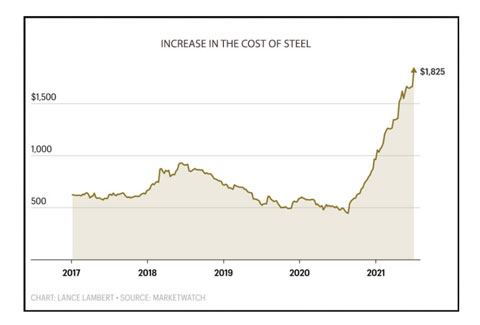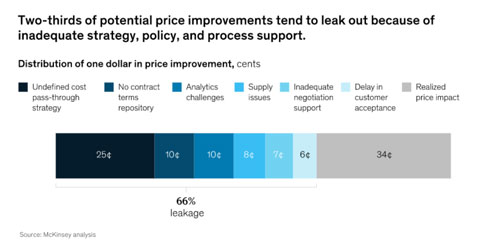Many years ago, when I was much younger, more attracted to risk and much less afraid of heights, I jumped out of a perfectly good airplane … with a fully-functioning, fully inspected parachute. Our jumpmaster - a person designated to train and guide us in parachuting - made sure we were well-prepared and made certain we never underestimated the danger involved nor the preparation necessary to land safely.
While the analogy could seem extreme, or the paradigm a bit removed from the business world, there are corollaries to what may be ahead for B2B pricing and sales teams in 2022 and beyond. So, buckle up, get your ‘chute’ ready to pull, and consider the need for a jumpmaster to support you before you take the leap.
An Unprecedented Climb
The global pandemic brought with it near-unprecedented challenges to keep prices market-aligned for B2B customers. Even pricing strategies grounded in advanced data analytics, informed by real-time market signals and supported by well-planned price execution kept pricing teams and sellers busier than ever as demand declined in some sectors and raw materials costs shot through the roof in others. One manufacturing company I talked to increased list prices eight times, in aggregate over 100%, in 2021. Others have tripled their prices. Steel prices alone tell the story of the acceleration of raw materials costs, which affected everything from aluminum to zinc, lumber to plastic, and everything in between.

Warning: Potentially Steep Grade Ahead?
While no one can say for sure, most executives believe raw material costs will come down in 2022 as supply chains are restored, inventories are replenished, and production output begins to catch up with demand. Nevertheless, both the challenge and opportunity of capturing or holding price (and therefore margin) is top-of-mind for most executives. When costs come down, eventually, there’s an expectation for price reductions, creating a bit of tug-of-war within sales channels – particularly channels involving distributors and dealers who are also trying to hold price along with manufacturers and suppliers.
Price changes, up or down, are not simple to carry out and can carry inherent financial risks. A recent study showed that poor management of pricing actions can wipe 66 cents off every dollar of potential price improvement. This suggests that two-thirds of the opportunity to hold price as costs come back down could be lost if the right strategies and tools are not in place, resulting in giving back too much. This is comparable to jumping out of a plane without a fully functioning parachute or no parachute at all.

What can I do now to ensure I ‘parachute’ safely and effectively in 2022?
Data and Analytics
Data is important for pricing in all market conditions. Historic data provides context for future pricing decisions and cost pass-through, up or down. By understanding and forecasting costs and supply and demand dynamics, B2B companies are prepared to execute more effectively on expected cost decreases (as well as future increases). By evaluating the margin contribution at the segment or customer level and understanding contractual obligations and opportunities for renegotiation in a systematic way enables proactive, timely and informed price setting decisions and effective price execution.
Strategy and Planning
Most would agree the primary objective of a sound pricing strategy is the protection of margins. But pricing teams also must keep their eye on revenue and be sensitive to the need to continue to grow while tempering the desire to grab market share through lower prices at suboptimal margins, as costs decrease. For price-sensitive commodity-based businesses that are highly affected by raw materials, the focus needs to be on rapid and full cost pass-through on the way up, careful and considered price decreases on the way down. In its simplest form, this is achieved by linking prices directly to commodity indices. But this approach can still:
- Be reactive or overly generous
- Lead to delayed cost pass-through and consequently margin loss on the way up
- Lead to overzealous price reductions on the way down to customers who previously benefited handsomely on the way up
This dynamic can be damaging even for a business selling specialized, differentiated products and services in which margins are not directly tied to cost movements but where expectations are tied to market factors.
Tracking, Reporting, Forecasting
Market leaders use advanced analytics and reporting for both tracking historical results and forecasting the future. When changes in raw material costs and imbalances between supply and demand come into play, they are prepared to meet these challenges that are not typically experienced in static markets. They have pre-built capabilities to proactively change their pricing and contracting approaches in all market conditions. Rapid identification of cost movements, combined with intelligent workflows to address outdated or margin-bleeding customer agreements that should be renegotiated, can result in quick wins and margin protection/enhancement.
Confidence, Conviction and Commitment
Sales teams can gain confidence in holding effective price-change conversations when they are armed with market-aligned pricing and the right messaging. Sellers will undoubtedly need to anticipate buyers’ questions and be comfortable discussing price. Organizations that have a comprehensive strategy and communication plan will find it much easier to not only institute price changes but to see those changes effectively executed in the market. Pricing and commercial Leaders who are focused on building sales teams’ confidence and arming sellers with what they need will find price-change conversations aren’t as risky as they might otherwise seem. Instead, they find, the context around price conversations can and should be seen as a win–win for both sides. Here are some more practical tips:
- Empower sellers with highly credible negotiation guidance
- Implement a process that provides sellers with approval thresholds tied to price guidance ranges
- Provide automated approvals where possible
- Supporting analysis where needed
- Make sure new price guidance is aligned with:
- Pricing Strategy
- Costs
- Other prices (products, customers, etc.)
Alignment with sellers builds confidence, conviction and commitment. That, combined with alignment to the market, will drive results.
Technology Investments
Many global companies, even the largest B2B enterprises, were ill-prepared over the last two years to appropriately price products in real time to maintain margins in such a fluid market. Lacking technology to implement dynamic pricing, they found themselves unable to keep pace with the acceleration of raw materials costs. This was made clear when companies started out in 2020 giving their customers 30-, 60- or even 90-day notice for price changes based on what they were seeing in cost changes - only to resort in 2021 to ‘effective immediately’ price changes just to keep up with their suppliers. The winners in 2022 and beyond will have technology to support potentially inevitable cost reductions that will allow them to dynamically preserve margins and enforce price changes that are acceptable to customers as well as to their leaders and investors. Technology will become their most valued ‘parachute’.
Zilliant has been enabling B2B companies to proactively deliver optimized prices in all market conditions for more than 20 years. We are a recognized leader according to the 2021 IDC Marketscape for Price Optimization and Management Applications, as our customers attest to Zilliant as a proven expert that can help you preserve margin and capture growth in 2022 and beyond.
Do you need a jumpmaster to help you parachute down? If you want to ensure you are prepared to take proactive action amidst future uncertainty, connect with me on LinkedIn, send me an email or contact our team here
